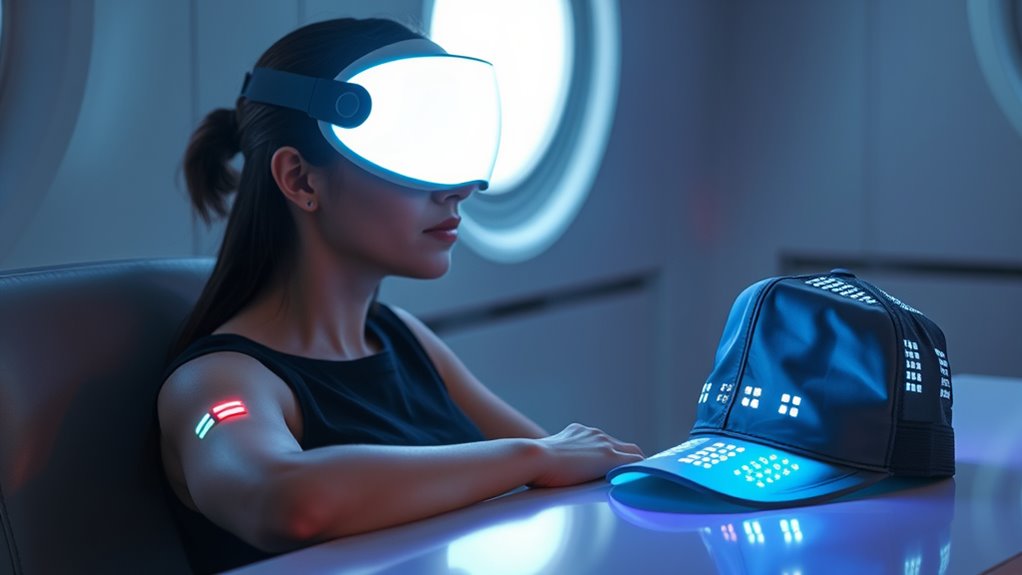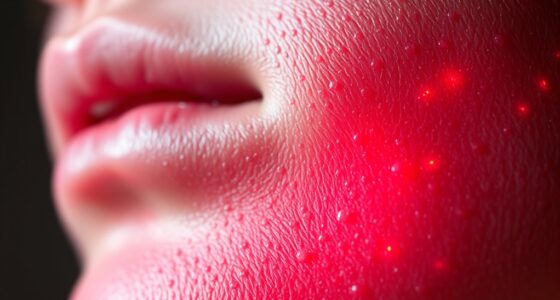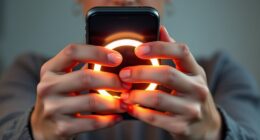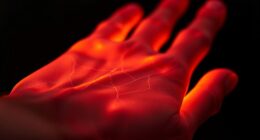Wearable light therapy devices like masks, patches, and hats use specific wavelengths to penetrate your skin and target underlying tissues. Red and near-infrared lights reach deeper layers, promoting cellular activity that can boost your mood and energy. The devices include safety features such as adjustable brightness and timers to prevent overexposure. By understanding how these tools work and their safety measures, you’ll see how they could benefit you—more details await if you continue exploring.
Key Takeaways
- Wearable light therapy devices include masks, patches, and hats designed for targeted treatment of skin or mood disorders.
- These devices use specific wavelengths (red, near-infrared, blue, white) to penetrate skin and activate cellular responses.
- Masks cover the face for facial or eye-related therapy, patches are applied to specific skin areas, hats deliver light to the scalp.
- Safety features like adjustable brightness, timers, and filters help ensure effective and safe sessions.
- Proper usage, including distance and session duration, maximizes benefits while minimizing risks like eye discomfort or skin irritation.
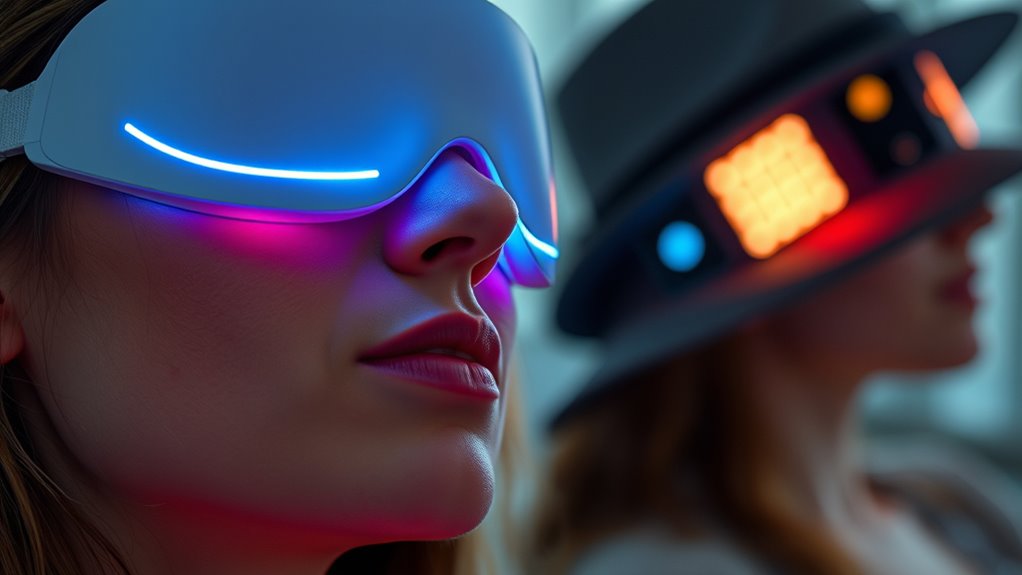
Have you ever wondered how wearable light therapy devices can improve your mood and energy levels? These innovative tools have gained popularity for their ability to boost well-being, but understanding how they work can help you make informed choices. One key aspect is how the light penetrates your skin, which involves skin absorption. When you wear a light therapy device, such as a mask, patch, or hat, the emitted light penetrates your skin to reach the underlying tissues. The wavelength of the light determines how deep it goes; for example, bright white or blue light targets the superficial layers, while red or near-infrared light can reach deeper tissues. This skin absorption process is essential because it influences the effectiveness of the therapy. The more efficiently the light is absorbed, the better your chances of activating cellular processes that regulate mood and energy. Manufacturers design devices to optimize skin absorption, making sure that the light penetrates just enough to stimulate your cells without causing harm.
Device safety is another critical consideration when choosing wearable light therapy tools. You want something that’s effective but also safe to use regularly. Reputable devices are built with safety features that minimize risks like eye strain or skin irritation. For instance, many come with adjustable brightness settings, timers, and protective filters to prevent overexposure. It’s necessary to follow the manufacturer’s instructions, such as maintaining a safe distance from your eyes and limiting session durations. While these devices are generally safe, improper use or choosing low-quality products can lead to side effects like headaches, eye discomfort, or skin redness. Always check for certification or approval from relevant health authorities, which indicates the device meets safety standards. Some devices also feature built-in safeguards like automatic shut-off or eye protection mechanisms, giving you peace of mind during use.
Additionally, it’s wise to consult with a healthcare professional before starting light therapy, especially if you have sensitive skin, eye conditions, or are taking medications that increase light sensitivity. Proper usage not only guarantees safety but also maximizes benefits. In brief, understanding how skin absorption influences the effectiveness of your device helps you appreciate how light therapy works. At the same time, prioritizing device safety ensures you enjoy the benefits without unnecessary risks. With the right device and proper precautions, wearable light therapy can be a safe and powerful tool to enhance your mood, boost your energy, and improve overall well-being.
Frequently Asked Questions
Are Wearable Light Therapy Devices Suitable for All Skin Types?
Wearable light therapy devices are generally suitable for most skin types, but your skin sensitivity matters. If you have sensitive skin, you should check device compatibility and start with shorter sessions to avoid irritation. It’s best to consult a dermatologist beforehand to guarantee the device suits your skin. Always follow the manufacturer’s instructions, and watch for any adverse reactions. Proper use helps you safely enjoy the benefits regardless of your skin type.
How Long Does It Take to See Results With Wearable Light Therapy?
You can typically expect to see results within 4 to 8 weeks of consistent use with wearable light therapy. The effectiveness timeline varies depending on your skin type and condition, but most users notice improvements in skin tone, texture, or mood by the end of this period. To maximize benefits, follow the recommended treatment schedule and be patient, as visible changes take time to develop.
Can Wearable Light Therapy Be Used Alongside Other Treatments?
Yes, you can use wearable light therapy alongside other treatments. It often complements skincare routines and fits well within a holistic wellness approach. Just make sure to consult your healthcare provider to guarantee no interactions or contraindications. Combining light therapy with other treatments can enhance overall results, but always follow professional advice to maximize safety and effectiveness in your skincare and wellness journey.
Are There Any Risks or Side Effects From Using Light Therapy Masks?
You might feel like light therapy masks are a gentle sunrise, but safety concerns exist. Side effects are usually mild, like skin irritation or dryness, similar to a sunburn if overexposed. Rarely, some people experience headaches or eye strain. Always follow instructions to minimize risks. If you notice redness or discomfort, stop use and consult a healthcare professional—think of it as tuning a delicate instrument to keep everything in harmony.
What Is the Recommended Frequency of Use for Optimal Benefits?
You should use your light therapy device about 4 to 7 times a week for ideal benefits. Maintain a consistent usage frequency to see the best results, but don’t overdo it. Follow maintenance tips like cleaning the device regularly and avoiding excessive exposure to bright lights outside therapy sessions. This consistency helps your skin adapt and maximizes the therapy’s effectiveness while minimizing potential side effects.
Conclusion
Now that you know the ins and outs of wearable light therapy, you’re better equipped to give it a shot and see if it’s right for you. These devices are changing the game, making treatment more accessible and convenient. Remember, don’t put all your eggs in one basket—consult with a healthcare professional before diving in. With the right approach, you might find that light therapy truly brightens your day, so why not give it a try?
